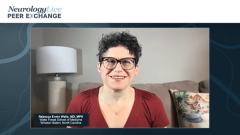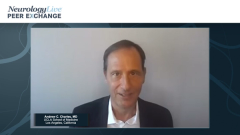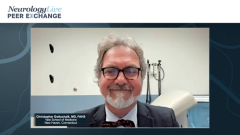
Headache Specialists for Preventative Migraine Treatments
A discussion on when a patient should be referred to a headache specialist for preventive migraine treatment.
Episodes in this series

Jessica Ailani, MD: In this last segment, we’ll be talking about best practices in preventive treatment for migraine. Stephanie, at what point should a patient be referred to a headache specialist?
Stephanie J. Nahas, MD, MSEd, FAHS, FAAN: Wow, what a great question. There’s no single best answer. It’s almost like when you know, you know. But you have to be paying attention to know when to know, right? Practice across the country varies a lot. It can be very tough to see a neurologist or even your primary care doctor because they see a lot of headaches, but they have higher-priority medical problems to take care of in a lot of their visits.
Migraine is very prevalent. It’s 12% of the waiting room, yet a small percentage of visits are dedicated to discussing or even looking for it. You have to be looking for it and trying to treat it in the first place. Then you have to know when you’ve reached your limit of what you’re comfortable with and what you’re willing to keep trying. You don’t want to keep trying and not have success. That detracts from even the strongest clinician-patient alliance, so know when. Maybe it’s like a “3 strikes and you’re out” scenario. Who knows? But that should be an individualized decision that’s discussed at length between the patient and their clinician.
Where headache specialists come in, obviously, is to offer some newer and more cutting-edge treatments that we’re more comfortable with because we’ve been using them longer. We know all the ins and outs and the tricks of how to deal with the payers to get them covered. We can do advanced therapeutic techniques, such as injections of onabotulinumtoxinA or nerve block and trigger-point injections, which can be done by anybody. But a lot of neurologists and primary care doctors don’t want to bother with it, so they’ll send them to us for that or more advanced care with infusion therapies, either through an outpatient infusion suite or in the hospital.
That’s where we come in, but it can’t be a handoff and bye-bye. No, we need to be part of the existing team. This is not necessarily a transfer of care. It’s pulling a new expert into the treatment team because a busy headache practice can’t necessarily see a patient as frequently as they may need to be seen to make those little tweaks. We can get a patient on the road to success with several ideas of step A, step B, and where our bifurcation points may come in. Then we arm the local doctor with that information, and they can tinker with it and massage it along until they can get back to the specialists, where we make another overhaul to the plan if it’s not working out properly. I could go on about this, but that’s my simple superficial answer.
Jessica Ailani, MD: These are really good points. It’s important to point out there are over 700 headache specialists in the United States to take care of around 40 million people with migraine—just migraine. We’re not talking about occipital neuralgia, cervicogenic headaches, or tension-type headache, which shouldn’t be seen by a headache specialist but sometimes end up with us. Trigeminal autonomic cephalgias also aren’t common but should be managed by a headache specialist and all the 200 other subtypes of headache disorders.
Oftentimes, the patient will come to us and want to stay with us, but we don’t always have the resources to do full-time management, so that partnership is essential. It’s an important thing to realize when you’re referring a patient over. Another essential thing is to understand there might be a wait. It’s always nice when I get a message from the patient’s primary care physician or neurologist saying, “What can I do in the meantime to help with all the work-up, or the studies, or a treatment that I should be starting this patient on? Here are their records.” I find that to be extremely helpful.
Just today I got a message like that from a primary care physician in my network, so I could see the patient’s chart. I saw that the patient had been on prevention and had just stopped it because she was lost to follow-up and had transitioned to our center, to our system. All I had to say was, “Why don’t you restart the patient’s prevention. I see that you already started her on her prior acute treatment, and you took documentation that she has a change in her headache type. Why don’t you order an MRI without gadolinium?” She’s already contacted us to make the appointment, so that’s awesome. While she’s waiting for the appointment, if all this gets done, she will be like 70% on her way by the time the appointment comes. She’ll be much better than calling us miserable every other day waiting for that appointment to start. Those are super-helpful things that people can do.
Chris, for the community neurologist who is starting a patient on preventive treatments for migraine, do you have any tips or tricks that you wanted to offer them?
Christopher Gottschalk, MD, FAHS: The main message I have for my colleagues in general neurology is to keep up the good work. What’s remarkable to see in the last 10 years or more is that more of our neurology colleagues are taking migraine on as a disease that they’re willing to treat, that they’re able to treat, and that they’re enthusiastic about treating. That has a lot to do with the fact that we have more treatments that are clearly effective and well tolerated. It’s unfortunately true that in the era I grew up in, in a large academic center in the United States, that most of my preceptors had the attitude that migraine was not part of neurology or it was not even necessarily a medical disorder. That transition, thank goodness, has made it into the modern era, where we’re seeing more clinicians of various stripes who understand that this is something they can treat and should treat, and that it’s 1 of the most rewarding things they can do.
Giving people pointers about having clear guidelines and goals of treatment are not necessarily hard lines. They understand what matters to patients, and maybe a preventive treatment— that means no more ED [emergency department] visits or attacks that are half as likely to be disabling, something like that—is more than enough. It’s not about a cure but it’s about the management and restoring function in some number of domains that really matter to them.
Jessica Ailani, MD: Thank you to our audience for watching this Neurology Live® Peer Exchange. I hope you’ve enjoyed watching this program as much as we’ve enjoyed spending this time together. If you’ve enjoyed this content, please subscribe to our e-newsletters to receive upcoming Peer Exchanges and other great content right in your in-box.
Transcript edited for clarity.
Newsletter
Keep your finger on the pulse of neurology—subscribe to NeurologyLive for expert interviews, new data, and breakthrough treatment updates.






























